Exhibit Review: D23 Presents – Treasures of the Walt Disney Archives

October 16, 2013, marked two major milestones in regards to Walt Disney, and the company he founded.
One of those events, was the 90th anniversary of the founding of The Walt Disney Company (formerly The Disney Brothers Studio).
The second event, was the official opening of the Treasures of the Walt Disney Archives, at Chicago’s Museum of Science and Industry. Originally, this exhibit had just been intended for an exclusive showing at the Ronald Reagan Library in 2012. However, some of the MSI staff were impressed by the presentation, and requested that the archive be brought to the Midwest.

David Mosena, President and CEO of The Museum of Science and Industry, welcomes the first visitors to the Museum’s Treasure of the Walt Disney Archives exhibit, on October 16, 2013. Joining him are Mickey Mouse, and Becky Cline, Director of The Walt Disney Archives
It may seem hard for the average person to believe, but Walt Disney was born in Chicago. As well, the Museum of Science and Industry is housed within a structure built for the 1893 World Columbian Exposition, of which Walt’s Father (Elias Disney) had a hand in some of the Exposition’s construction work.
The house Walt was born in still resides on the northwest side of Chicago, and he took classes at The Art Institute of Chicago in his late teens.
Regarding exhibition theming, the Archives exhibit at the Museum is meant as less of a tribute to The Walt Disney Company, and moreso a testament to Walt Disney, and what he achieved over the course of his life.
Over 300 artifacts are housed within the exhibit, many of them things that we have often seen as pictures, or within a flickering television screen. It is the ability to see these items up close that is one of the highlights of the exhibit.
 One that is still mind-boggling to me, was this original telegram Walt sent Roy from St Louis, telling him “Everything is OK.” I had seen reprints of this important piece of Disneyana in Bob Thomas’ Art of Animation book, and at The Walt Disney Family Museum, but this was almost on the same level as seeing an original Monet (yes, I’m that much of a nut to compare a telegram to a Monet).
One that is still mind-boggling to me, was this original telegram Walt sent Roy from St Louis, telling him “Everything is OK.” I had seen reprints of this important piece of Disneyana in Bob Thomas’ Art of Animation book, and at The Walt Disney Family Museum, but this was almost on the same level as seeing an original Monet (yes, I’m that much of a nut to compare a telegram to a Monet).
The telegram was sent during a turning point for Walt: it belied the news to his brother Roy, that he had lost control of Oswald the Lucky Rabbit to Universal Pictures, and on the train ride back to California, Walt would develop his next big character: Mickey Mouse.
There is even a small case showing numerous pieces of merchandise related to Oswald, and one showing several of Mickey’s early items. Mickey’s first merchandising image was on a writing tablet (aka a small paper pad), and the exhibit has one in amazing condition. As someone who had read about this item, I was impressed to see it in the collection.
 Naturally, the sections dealing with the animation process were the most interesting to me. There are such highlights as an original animator’s work desk, original jars of paint from the now-defunct ink-and-paint department, and sculptural models (aka maquettes) that helped the animators see their characters in 3 dimensions.
Naturally, the sections dealing with the animation process were the most interesting to me. There are such highlights as an original animator’s work desk, original jars of paint from the now-defunct ink-and-paint department, and sculptural models (aka maquettes) that helped the animators see their characters in 3 dimensions.
Just as magical, though a little less hand-drawn, were the original storybooks that ‘opened’ the films Snow White, Cinderella, & Sleeping Beauty (seen above). There’s some beautiful detail that you might not recall, or never even considered. For example, you wouldn’t realize it from the opening scene of Sleeping Beauty, but that book prop is huge!
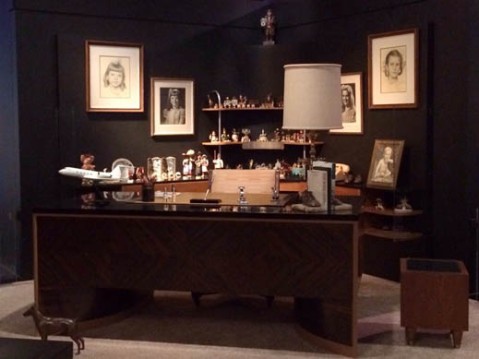
However, the centerpiece of the exhibit (and it is at the center!), is a ‘partial’ recreation of Walt’s office. Word was the entire room was sealed up upon Walt’s death (reason: unknown), and was not reopened until 4 years later, when Dave Smith was hired as the company’s first archivest. He was one of the first to enter the office, and catalogued everything that was in the room. The entire layout of Walt’s desk and the mementos on it, are exactly as it was found back in 1970. Word was, photographs were taken of everything as it was, and filled a binder several inches thick!
Much of the information contained within the area was eye-opening to some. One woman who I spoke with, had never heard about animator Ub Iwerks (who was one of Walt’s friends from his Kansas City days, and the main animator on the early Mickey Mouse shorts). She was quick to point out how informative the exhibit was, though it was I who convinced her that Walt Disney’s body was not frozen (seriously, she believed that rumor!).

Speaking of eye-opening, I was intrigued by the following jars of paint (above). It wasn’t so much the color labels, but the notations on the “Art Gallery” tags. The left jar is labelled “her lower body,” and the right jar has “Devil-Eyes” written in. I’m wondering if these color jars are for Sleeping Beauty, as the blue could have been used for the lower portion of Aurora’s blue dress. So…could that mean the “Devil-Eyes” jar could have been used for…Maleficent?
 During our tour, we were accompanied by Becky Cline and Nicholas Vega (both are pictured to the left). Becky is the director of The Walt Disney Archives, and Nicholas is the manager of collections and exhibits for the Archives.
During our tour, we were accompanied by Becky Cline and Nicholas Vega (both are pictured to the left). Becky is the director of The Walt Disney Archives, and Nicholas is the manager of collections and exhibits for the Archives.
Becky was also quick to mention that while there are animation items like concept art and animation cels within the exhibit, those are provided by the company’s Animation Research Library, and not the Archives. The Archive is responsible for collecting items like film props, costumes, merchandise, and even personal effects of Walt’s.
Given that Becky and Nicholas had seen their fair share of archival material over the years, I had to know: was there something missing from the archives that they would love to have?
Probably given the atmosphere (and the eventual golden anniversary next year), both of them cited items from Mary Poppins.
Becky mentioned that while they had several of Mary’s items, the Archives did not have one of the original parrot-head/umbrella props. As for Nicholas, his dream prop was related to Dick Van Dyke’s character of Bert. Strange as it may seem, not a single piece of Van Dyke’s original wardrobe from the film could be located!
Becky also noted that one of the reasons for this, was that the Archives was not officially started until 1970, when Dave Smith was hired. As such, much of the main material from older live-action films like Treasure Island, Old Yeller, and The Parent Trap are gone. However, some items pop up from time to time, like Mary Poppins’ original carpetbag, which was obtained by the Archives a few years ago.
 Of course, since the resurgence of the company in the 1980’s, a lot of the current items are preserved. Unlike the large swath of material at the Reagan exhibit, MSI is displaying just a few choice pieces from the films made after Walt’s passing, including several wardrobe pieces from the last 2 decades. While we do have the wardrobes of Captain Jack Sparrow and Enchanted’s Giselle, there is also the original wardrobe of the Rocketeer (complete with jetpack!), and Hocus Pocus‘ Winifred (pictured on the right, complete with book!). And, for you young’uns out there, a Wildcats basketball outfit from High School Musical.
Of course, since the resurgence of the company in the 1980’s, a lot of the current items are preserved. Unlike the large swath of material at the Reagan exhibit, MSI is displaying just a few choice pieces from the films made after Walt’s passing, including several wardrobe pieces from the last 2 decades. While we do have the wardrobes of Captain Jack Sparrow and Enchanted’s Giselle, there is also the original wardrobe of the Rocketeer (complete with jetpack!), and Hocus Pocus‘ Winifred (pictured on the right, complete with book!). And, for you young’uns out there, a Wildcats basketball outfit from High School Musical.
To me, this is where the exhibit ‘peters out.’ The items from Disney beyond Walt’s time feel a little hodge-podge, spread out in a way that doesn’t feel as proper as the Archives’ story on Walt Disney, the man.
There is a large chunk of wall space included to tell about the iPad app Disney Animated, but it just feels like you could have included some concept/production art from animation done over the last 40 years in that space. While digital technology can be exciting, nothing beats some eye-opening originals.
Unlike the Reagan presentation, a learning experience has been folded into the exhibit, with some small activities for children. The end of the exhibit also features an Animation Academy, where you can learn to draw Mickey Mouse.
While it is a fun activity for children, I feel that the Animation Academy at the end, could have been moved to another area outside the exhibit. The space that it occupies, could have been used as a larger display/staging area for the post-Walt period. Maybe even include video testimonials of those who work within the company today, and tell how what they learned from Walt, has pushed them to keep moving forward, as well as honor his legacy.
Speaking of Walt, what I was most pleased to see, was the exhibit showing people that before his successes in animation, Walt was just as ordinary as any of us. One example is the image below, in which Walt (center) is having a scene filmed with his friend and fellow animator Ub Iwerks (left), on the roof of the building where their Kansas City studio was housed.

The ability to show people pictures of Walt as a child and a young man, is a great way to make younger viewers think, “hey, maybe one day I can do something like that!”
As of now, the Archives exhibit is only scheduled to run through May 4, 2014. While this is the first showing of this material outside the state of California, no other venues have been scheduled (so far).
The Museum of Science and Industry has played host to a number of exhibits regarding entertainment-related properties or creators, such as Harry Potter, Jim Henson, & Charles M Schulz, to name a few. What they have put together with Treasures of the Walt Disney Archives, is definitely a home run, and is an attraction that I believe will be a big draw not just for tourists, but local Chicagoans as well (I’m already eager to round up some close friends, and take them through it!). Because of this, I have tried to keep myself from revealing as much about the display pieces as I can. During my time inside the exhibit, I took over 200 images!
It should also be noted that several items may be changed out soon due to their age. According to Becky and Nicholas, Walt’s original telegram to Roy is only set to be on display for a month, before a reproduction will take its place. Even some original posters from the early 1920’s Alice Comedies (a series of live-action/animated shorts done in the mid-20’s), will be swapped out with other posters from the series.
I usually like to close some of my posts with a few choice words. These quotes from CBS Evening News anchor Eric Sevareid (made on the evening after Walt’s death was announced), provide a thoughtful moment (and can be found in the exhibit):

A bust of Walt, sculpted by Gustavo A Fernandez
“He was not just an American original, but an original. Period…”
“He probably did more to heal – or at least soothe – troubled human spirits than all the psychiatrists in the world. There can’t be many adults in the allegedly civilized parts of the globe who did not inhabit Disney’s mind and imagination for at least for a few hours and feel better for the visitation.”
“What Disney seemed to know was that while there is very little grown-up in every child, there is a lot of child in every grown-up. To a child, this weary world is brand-new, gift-wrapped. Disney tried to keep it that way for adults.”
*Special Thanks goes to D23 and The Museum of Science and Industry, for including me in their early event viewing for internet bloggers. It was definitely an exciting day, and a memorable experience.*
An Animated Dissection: Does Ratatouille contain metaphors for The Walt Disney Company?
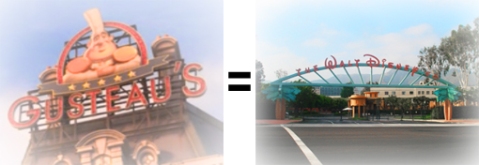
As the mid 2000’s began to roll around, a pall of uncertainty hung over fans of Pixar Animation Studios. With the company getting ready to release Cars, there was a tug-of-war going on between the studio and The Walt Disney Company, with neither side willing to budge.
At stake were millions of dollars that Disney wanted to cash in on asap. At the time, they had quickly assembled a group called Circle 7 Animation, which were tasked with churning out sequels to Pixar films like Toy Story, Finding Nemo, & Monsters, Inc. The writing was on the wall:
“Even though you made those films, we own the characters. You can cry all you want, but we’re gonna make as many sequels as we want, with or without you!”
Luckily, Michael Eisner was ousted as Disney’s CEO, and Bob Iger came onboard. Iger became the peacemaker that was sorely needed, even if his methods were seen as shocking when the deal for Pixar amounted to a $7.4 billion acquisition. But along with keeping one of the world’s most successful studios within the folds of Disney, several of Pixar’s top players came onboard to help Disney as well.
Steve Jobs became one of the biggest shareholders on the company’s board, while Ed Catmull & former Disney animator John Lasseter would oversee the then-floundering feature animation division. John would also come on board to help revive the company’s theme park division (including major input into the just-completed $1.1 billion revamp/expansion of Disney’s California Adventure in Anaheim, CA).
But, I’ve gone off the track and jumped to today. Let’s backtrack to that uncertain period of time. As the Disney/Pixar deal was set to expire, one film remained in limbo regarding what would become of it: Ratatouille.
Originally conceived by Jan Pinkava (director of the award-winning Pixar short, Geri’s Game), the story was revamped by Brad Bird, but held onto the concept of a rat with exquisite culinary tastes, who wants to achieve the impossible: becoming a chef.
At the time, the concept being pitched for the film seemed as head-scratching to alot of people, as John Lasseter’s want of a film about talking cars. Ratatouille was a film that was probably one of the toughest for the studio to market. Probably not since The Incredibles had a Pixar film been released with such a low volume of merchandise (of which the majority was only available at The Disney Store). Even so, it became a surprise (if modest) hit in the United States, and netted Pixar its third Best Animated Feature statuette the following spring at The Academy Awards.
After watching the film a few times, I couldn’t help but wonder about some of its content. The film was being made during a turbulent time between Disney and Pixar, and several points of the film seemed to reflect a bit on both of the studios. I have never really heard anyone do a comparison, so I decided to sit down and write this.
__________
1) Gusteau and his restaurant = Walt Disney, and The Walt Disney Company
The film’s famous chef Auguste Gusteau is considered to be one of the world’s premier chefs, whose creativity and skills are loved by almost everyone the world over. Gusteau seemed to encourage others to go out and achieve greatness themselves, and just by what they talk about regarding him, he did not shy away from trying things that may or may not work (we hear of such a thing in the film, when Skinner tasks Linguini to prepare the dish ‘Sweet Bread ala Gusteau,’ a recipe that was considered ‘a disaster’).
This was the mantra that Walt Disney worked with through much of his life. He wanted to do things that noone else had considered or achieved. Some of his ideas achieved great success (the creation of Mickey Mouse, and the film Snow White), and others did not fare so well (such as his attempts to elevate the art form of animation with Fantasia in 1940).
__________
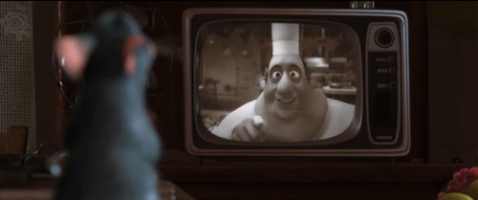
2) Remy and his adoration of Gusteau = Pixar Animation Studios
Remy subscribes greatly to Gusteau’s recipes, and at the beginning, we also see him watching some culinary programs, in which Gusteau gives his opinion on food preparation. Here’s one of the quotes:
“You must be imaginative, strong-hearted. You must try things that may not work, and you must not let anyone define your limits because of where you come from. Your only limit is your soul. What I say is true – anyone can cook… but only the fearless can be great.”
This could be seen as metaphorical to how many animators/artisans admired Walt Disney and his studio guys for achieving what many people said were stupid ideas (such as adding sound to film, adding color, and making a full-length ‘cartoon’ film for example).
While Pixar would hold true to their love of Disney, they would also try to break new ground by doing things differently. When they were given the green light to create their own feature-length film, they wanted to go their own way. They didn’t want to ‘copy’ Disney and make a musical or a fairy tale story, or adapt a story into a feature (all of which were popularly being ‘copied’ by Disney’s competitors at the time). Instead, the guys created an original story of their own, and in their daring to be different (but still adhere to the principles of Disney storytelling and animation), crafted something that surprised almost everybody!
Remy’s preparations in the kitchen that lead to new and exciting dishes could definitely be seen as comparable to what many were saying when Pixar’s films surprised many.
__________
3) Do Something Unexpected vs Follow The Recipes
Collette is given the task of showing Linguini what to do around the kitchen at Gusteau’s. During a portion of their tasks, she tells him how in studying Gusteau’s recipes, she noticed he often did unexpected things. This causes Linguini to begin writing down to “Always do something unexpected,” but is quickly reprimanded by Collette.
“It was his job to be unexpected,” she says. “It is our job, to follow the recipes.”
This scene almost seems to speak of the stagnation of The Walt Disney Company in the wake of Walt’s death. During his lifetime, almost all major decisions were largely decided upon by Walt, and he was often known for wanting to do the unexpected. But once he was gone, the company entered into a period where the company struggled to just stay afloat. The 1970’s brought very little change or innovation. And even those who attempted to do something unexpected were often discounted, or met with disdain.
The animation department continued to “follow the recipes.” There was very little that innovated. The stories often seemed ‘safe’ enough, but none really seemed to jump out and take hold of people.
Of course, doing something unexpected will not guarantee one success. Walt’s grand experiment with music and animation, Fantasia, failed to find favor with audiences in 1940. The same could almost be said in 1984, when the company made an unexpected turn in storytelling, and made The Black Cauldron. However, this attempt to do something unexpected, didn’t yield results, and became a costly quagmire that almost sunk the studio’s animation division.
__________
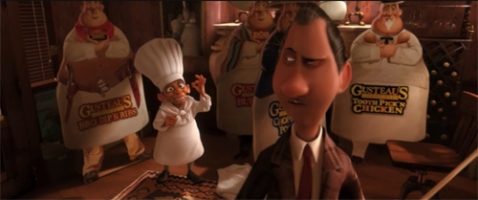
4) Skinner and commercialism = The Walt Disney Studios
Once Gusteau died, the business was turned over to his souse chef, Skinner.
It seems that Skinner just did not have (or did not want) to explore new territory regarding food. Instead, the restaurant chose to serve the same dishes that had been thought up and prepared by Gusteau, and Skinner chose to capitalize off of Gusteau’s image and name as well. The name was famous enough to stand for ‘quality,’ but many were forced to watch as it was used to hawk everything from microwave burritos to ‘chopsocky pockets.’
The fact that Gusteau’s ‘stalled’ with the death of its namesake, is almost reminiscent of what became of the Walt Disney Company when Walt passed away. You were stuck with a crew of people, and the guy who called the shots was now gone. There was very little direction being given, and the 1970’s and early 1980’s became ‘the dark times’ for the studio. Almost none of their live-action efforts succeeded in being as magical as films like 20,000 Leagues Under the Sea or Mary Poppins. Plus, the animation division at Disney kept getting hacked to ribbons until it soon numbered under 100 people. There were those who yearned to do what had once made the studio great, but at that time, it looked like the time for reawakening was gone for good.
The merchandising of the studio’s properties really began to kick into overdrive with the studio’s second animation renaissance in the 1990’s, and has been on a meteoric rise ever since, with one example being the billion-dollar Princess line. Many have incited Disney for seeming to slap their name and their familiar characters on everything, from apple slices to credit cards.
Of course, not all products are great. The name can often be slapped on things that seem very uncharacteristic to how people see the company, and over the years, many have been upset at the tarnishing of the brand name used for quick profit. For myself, the Disney name slapped on direct-to-video sequels like Cinderella II (a title that makes me shudder even now) definitely had an impact on how I perceived their operations at the time.
__________
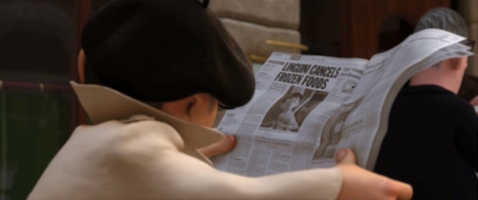
5) Restoring the luster to tarnished names and reputations
Once it is found out that Linguini is Gusteau’s heir, the company’s holdings are turned over to him. One of the biggest changes he makes, is the cancellation of the frozen foods line that Skinner had been working on.
This feels very similar to what happened at the Walt Disney Studios after the Pixar acquisition. Though there wasn’t an outright stop to the merchandising machine (you can’t just derail something that nets that much money to a company like that), there was an attempt to stop what was being largely seen as ruining the studios reputation. Such changes included:
1) The dismantling of Circle 7 Animation, allowing that the creation of any sequels/prequels to Pixar films, were to be created and decided upon by Pixar themselves.
2) The dismantling of the direct-to-video sequel productions that had been such a big money maker for over a decade.
While executives at Disney may have cried foul that profits were being sacrificed, the new management painted a different picture for them: a return to quality, which was eagerly welcomed by many (including several of the company’s shareholders).
__________
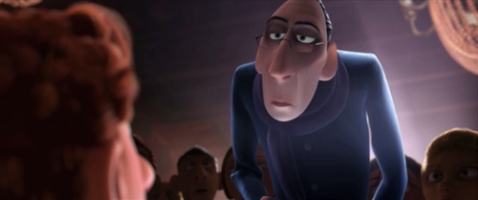
6) Anton Ego = Steve Jobs
This is one of those comparisons that could be stretching things, but just remember, this article is largely my mind making comparisons.
While Steve Jobs doesn’t quite have the reputation of Anton Ego (nicknamed ‘The Grim Eater’), both are men who are very picky when it comes to quality and presentation. Both men will settle for nothing less than perfection.
__________

7) La Ratatouille = PIXAR Animation Studios
At the end of the film, Gusteau’s is shut down once Skinner and a health inspector report that there were rats in the restaurant’s kitchen. However, where one door closes, another opens. Anton Ego ends up becoming a business partner when Linguini and Collette choose to open a small bistro, named La Ratatouille. Here, Remy can continue to cook and create new dishes, satisfying his needs, and carrying on the traditions of Auguste Gusteau.
One could almost fold the Anton Ego/Steve Jobs comparison into this one. Both men were sold off on a concept, and put down money to invest in a business.
In the case of Steve Jobs, this came about when in the early 1980’s, Pixar was a company division that was being considered for shutdown by their owner: Lucasfilm, LTD. Several of the people in the division felt there was potential to keep Pixar alive, and eventually got the attention of Steve Jobs. Jobs bought into their spirit, along with the dream that one day, Pixar could achieve the impossible, of creating the world’s first computer-animated feature film. The gamble paid off when almost a decade later, Toy Story was released into theaters.
Pixar was considered by some to be ‘out-Disneying’ Disney, given that they were creating heartfelt, emotional films that were enchanting audiences, and raking in more money than Disney’s animation output.
__________
Along with the comparisons above, there were a few that I felt could be even mover overreaching. I’m including them down here as honorable mentions:
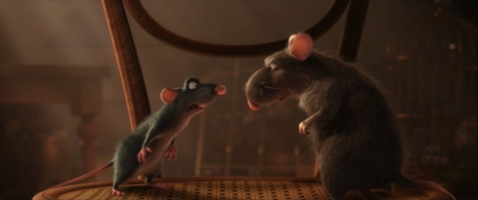
Honorable Mention 1 : Remy = Brad Bird
In the colony where he is part of, Remy is often the odd rat out. He often doesn’t see eye-to-eye on a number of things, and is often at odds with his father, Django.
One thing they disagree on is food. Remy only wants to partake of ‘the good stuff,’ but to Django, there’s very little choice in being picky.
Later on, when the family is reunited in Paris, Django grows concerned that Remy is interacting with humans, and shows him a window filled with dead rats, rat traps, and poisons. Django claims that certain rules and ways are set, and that they can’t expect change, but Remy refuses, and claims that change can be accomplished, willing to continue to put himself on the line to do something different.
Throughout much of his career, Brad Bird has been a guy who has wanted to often achieve and do things differently. In the mid-1980’s, he wanted to do an animated feature based on Will Eisner’s comic, The Spirit. Unfortunately, that project never got off the ground. Even so, Brad continued to push the envelope whenever he could:
– he served as a creative consultant on The Simpsons
– he created one of the best non-Disney/non-Pixar films in 1999, with The Iron Giant, a film that became a classic shortly after it tanked at the box-office.
It was Bird’s vision of an animated film about a family of superheroes that intrigued his school chum, John Lasseter, and John soon invited Brad and some of his cohorts on Iron Giant up to Pt Richmond, CA (where Pixar’s was first located outside of Lucasfilm) to develop their vision.
However, being part of Pixar didn’t give Brad a free ride to do anything he wanted. At the first pitch of the idea to Disney, one executive said, “Ok Brad, there are some things you can, and can’t do in animation.” He then proceeded to rattle off a list of things, and supposedly, Brad did the best he could to control himself (note: information of this can be found on a retrospect on the Blu-Ray disc of The Incredibles). To counter this, John Lasseter explained that they were just going to ‘explore’ Brad’s concept, and soon, that ‘exploration’ turned into one of the studio’s most loved films.
Of course, Brad still continues to try and shake things up. Just take 2011’s Mission Impossible: Ghost Protocol. In this film, Brad chose to not give us a generic Tom Cruise film, but shook things up in numerous ways. The IMF team are forced to go rogue, and almost none of their fancy gadgets seem to work. So what is there to rely on? Each other. Brad’s turn of making the film more about the people and less about the spectacle, almost seemed to hint at Pixar‘s own philosophy, that it’s the people working on their films that make all the difference.
__________

Honorable Mention 2 : Anyone Can Cook = The Illusion of Life
Aside from seeing some culinary shows talking about Auguste Gusteau, much of what Remy learns comes from Gusteau’s book, Anyone Can Cook. It’s filled with recipes, and a number of things relating to the chef and his restaurant.
In some ways, this reminded me of the book The Illusion of Life: Disney Animation, written by former animators Frank Thomas and Ollie Johnston. Their book has often been considered the Animation Bible when it comes to technique and study. The Illusion of Life chronicles a little of the men’s lives, but also tells of the early days of the studio, the first major animation talent that was in place when they came on board in the late 1930’s, and also the methods and techniques from turning moving drawings, into ‘moving drawings.’
__________
And, there you have it. 5 years of these comparisons percolating in my brain, and I finally got (most) of them out. I will admit this is not the only film that seems to spout some metaphors to The Walt Disney Company. Blue Sky Studios‘ 2004 film Robots also contains some comparisons as well, and I may just do an article on them for a future Animated Dissection.
